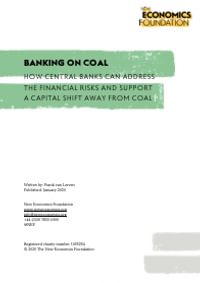Banking on coal
How central banks can address the financial risks and support a capital shift away from coal.
05 February 2020
Executive summary
- Coal is the single largest source of greenhouse gas emissions globally – and still expanding.
- Globally, the use of coal for electricity production has to fall by two thirds until 2030 and to nearly zero by 2050 to keep the increase in global temperatures below 1.5 degrees. Analysis based on “oldest-first” retirements of coal-fired power units highlight the need for a complete phase-out of coal across the OECD by 2030.
- With 4 out of 5 coal EU power plants unprofitable and utilities facing loses of €6.6 billion in 2019 alone, a rapid phase-out of coal is critical to account for the financial risks of coal investments and the potential of “asset stranding”.
- Central banks and financial supervisors are a critical catalyst in channeling capital flows and ensuring the resilience of the financial system and thus play a vital role in reducing the funding of coal – in particular by:
- excluding coal-exposed assets from central banks collateral frameworks and asset purchases,
- accounting for coal risks in setting microprudential capital requirements,
- introducing macroprudential capital buffers for coal exposures,
- and ensuring that the risks of coal asset stranding are adequately reflected in stress tests.
- Central banks across the world have exposures to coal through their collateral frameworks as well as the assets they hold. The balance sheets of major central banks today stand at more than 20 trillion USD. At least 627 billion USD of that total is allocated to equities and corporate bonds. Assuming that just 2% of this sum is linked to coal-exposed assets, central bank coal exposures would amount to more than 12 billion USD. Removing this exposure is critical and urgent.
- Coal-related risks are not sufficiently accounted for in current risk analysis. Ensuring that these risks are adequately reflected in both microprudential and macroprudential supervision is vital.
- The Bank of England has taken the first steps towards stress testing the financial sector for the stranding of fossil fuel assets in general and coal assets in particular. Further financial authorities need to follow its lead.
- Key institutions to advance this agenda comprise leading central banks (e.g. Bank of England, Bank of Japan, European Central Bank, Federal Reserve, People’s Bank of China, SNB), rating agencies (e.g. DBRS, Fitch Ratings, Moody’s, Standard & Poor’s), as well as the IMF and the World Bank.
Photo by Paweł Czerwiński on Unsplash.
Topics Energy Environment Banking & finance







